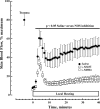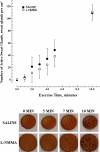Nonselective NOS inhibition blunts the sweat response to exercise in a warm environment
- PMID: 19131481
- PMCID: PMC2660248
- DOI: 10.1152/japplphysiol.90809.2008
Nonselective NOS inhibition blunts the sweat response to exercise in a warm environment
Abstract
The role of nitric oxide synthase (NOS) inhibition in modulating human thermoregulatory control of sweating and cutaneous dilation was examined in 10 subjects (5 men and 5 women). Three intradermal microdialysis probes were placed in nonglabrous skin of the dorsum of the forearm. The control site was perfused with 0.9% saline, while the two remaining sites were perfused with a nonselective NOS inhibitor: 10 mM N(G)-nitro-L-arginine (L-NAME) or 10 mM N(G)-monomethyl-L-arginine (L-NMMA). Local sweat rate (SR) and skin blood flow (laser-Doppler velocimetry) were monitored directly over the path of the intradermal microdialysis probe while arterial blood pressure was measured in the opposite arm noninvasively. Thermoregulatory responses were induced by cycle ergometer exercise (60% peak oxygen consumption) in a warm environment (30 degrees C). Esophageal temperature increased 1.5 +/- 0.2 degrees C during the 30 min of exercise. The cutaneous dilator response between 5 and 30 min of exercise in the heat was attenuated by both 10 mM L-NAME and 10 mM L-NMMA (P < 0.05). However, 10 mM L-NAME was more effective in blunting the rise in cutaneous vascular conductance during exercise than L-NMMA (P < 0.05). NOS inhibition also reduced the rise in local SR between 10 and 30 min of exercise (P < 0.05). In this case, 10 mM L-NMMA was more effective in limiting the increase in local SR than 10 mM L-NAME (P < 0.05). We conclude that local production of nitric oxide in the skin or around the sweat gland augments local SR and cutaneous dilation during exercise in the heat.
Figures





References
-
- Anderson MP, Sheppard DN, Berger HA, Welsh MJ. Chloride channels in the apical membrane of normal and cystic fibrosis airway and intestinal epithelia. Am J Physiol Lung Cell Mol Physiol 263: L1–L14, 1992. - PubMed
-
- Bertrand CA, Frizzell RA. The role of regulated CFTR trafficking in epithelial secretion. Am J Physiol Cell Physiol 285: C1–C18, 2003. - PubMed
-
- Bijman J, Quinton PM. Predominantly beta-adrenergic control of equine sweating. Am J Physiol Regul Integr Comp Physiol 246: R349–R353, 1984. - PubMed
-
- Boer R, Ulrich WR, Klein T, Mirau B, Haas S, Baur I. The inhibitory potency and selectivity of arginine substrate site nitric-oxide synthase inhibitors is solely determined by their affinity toward the different isoenzymes. Mol Pharmacol 58: 1026–1034, 2000. - PubMed
Publication types
MeSH terms
Substances
Grants and funding
LinkOut - more resources
Full Text Sources
Research Materials

